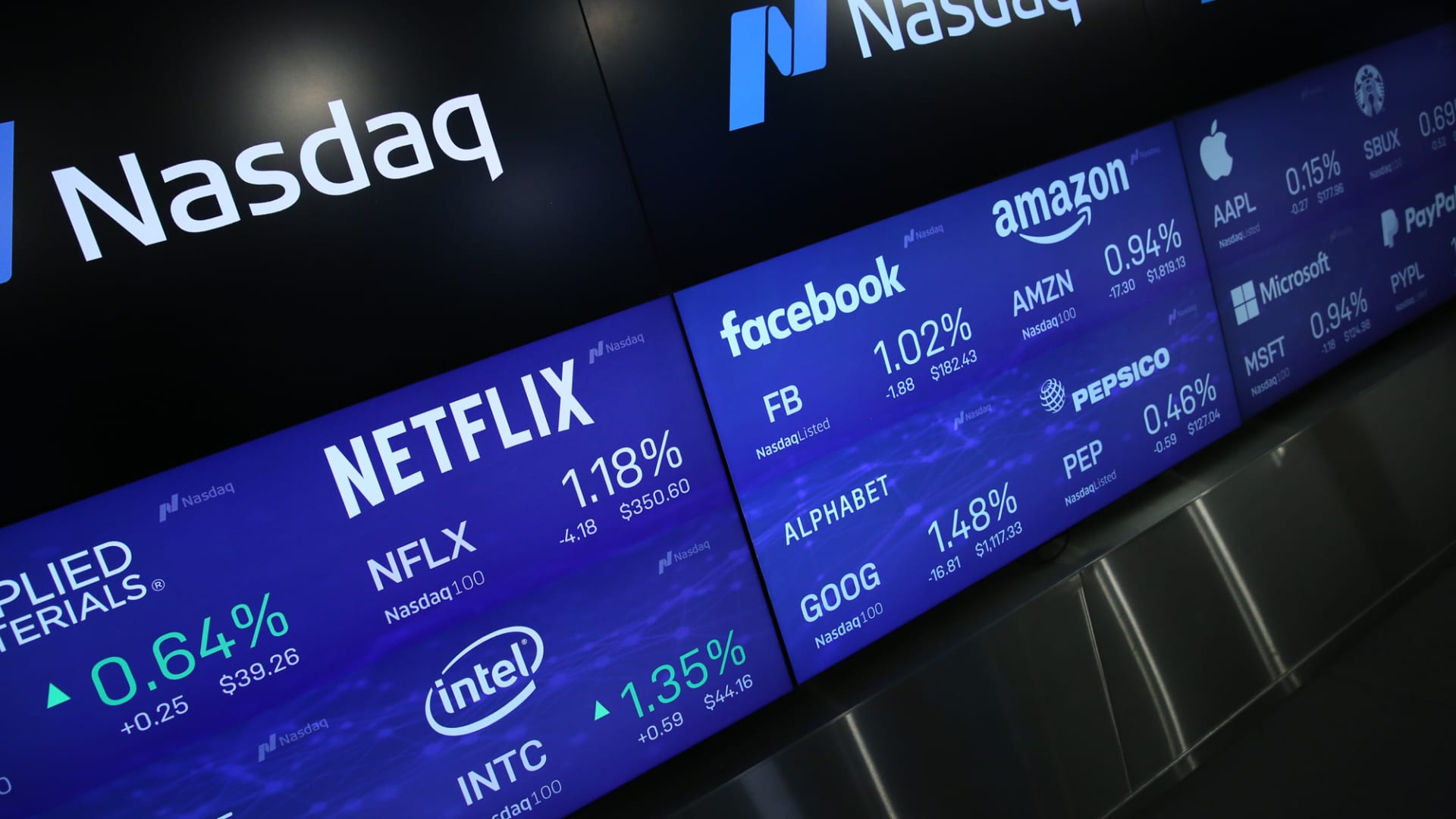Technology stocks have plummeted toward multiyear lows in recent months as investors search for stable, reliable earnings. The tech-heavy Nasdaq Composite sits 25.2% off its highs, and the index has suffered its worst start to a year on record. As tech stocks have tumbled, investors believe there are some values to be had in select areas while other parts of the industry will remain broken for a while. Many megacap names like Alphabet and Amazon have fallen 20% to 30% or more so far this year. Snap’ s profit warning cratered its stock and chopped more than 40% off its value on Tuesday, carrying shares of tech stocks down with it. In one three-day stretch in May alone, technology behemoths lost more than $1 trillion in value as investors’ appetite for growth stocks dried up in favor of what’s deemed safer parts of the market. UBS on Friday said it expects global tech earnings to grow by a low-teens percentage, compared with its previous mid-teens forecast. The bank said investors can use current conditions to rebalance portfolios and increase exposure to quality names in artificial intelligence, cybersecurity and big data. Much of the volatility in the markets stems from uncertainty surrounding the Federal Reserve’s rate hikes and surging inflation. In addition, while many stocks are trading at lows, not every heavily sold name is a bargain. Further losses could be ahead, especially since many companies continue to burn large amounts of cash due to rising costs. “Until the Fed is done raising rates, you have no idea where the bottom is, and valuations are still incredibly high” said Satori Fund’s Dan Niles. “Anybody who thinks a stock is cheap because it’s just down 50% or 75% from its highs, that’s a ridiculous way to measure this stuff, because if you look at the overall market in which all of these stocks trade it’s still incredibly expensive.” CNBC spoke with several big investors who offered up their strategies for finding value during the current market shake-out. Signals from tech bellwethers and inflation Recent earnings outlooks from the likes of Nvidia , Snap and others show weaker growth ahead. Snap saw its worst trading day ever this week after warning that it expects to miss the forecast it gave only a few weeks ago. The rapid deterioration of Snap’s outlook is a cautionary sign for consumer spending, said Gene Munster, a managing partner at Loup Ventures, and reinforces his guarded stance on tech in general. Munster has about half of his holdings in cash because he anticipates more pain ahead in the market. “Our belief is that we’re going to see some more negative news when companies report their June and September quarters. That belief has increased,” he said. At the root of the trouble is inflation, which is running at a 40-year high, and the Federal Reserve’s attempt to get it under control by raising interest rates and slowing demand, he said. Munster is watching a basket of commodities — everything from oil and natural gas, to lumber, oats and orange juice — for signs that inflation’s chokehold is loosening. That’s “really, at the core, the essence of what is impacting consumers,” he said. Munster expects to see investors easing back into tech stocks later this year, as growth expectations reset. “By the time you get to the end of 2022, there’s going to be an abundance of negativity priced into these stocks and the pendulum is going to probably overcorrect,” Munster said. Many stocks in the sector are also trading at strong discounts on a forward price-to-earnings basis, well below their average historic valuations over the past five years. Some are also trading behind their P/E at the start of 2022. Alphabet, for example, sports a forward P/E of 18.6 compared to an average of 25.6 over the past five years. Meanwhile, Meta Platforms is trading at just 15.4 times forward earnings versus a five-year average of 23.4. At the start of the year, its forward P/E stood at 23.6. Perhaps one of the strongest illustrations is Nvidia with a forward P/E of 32.2, down from 57.8 at the beginning of the year and 39.8 on average over the past five years. Picking a strategy Investors who want to play the tech sector but minimize risk should consider investing in index funds. Niles, Satori Fund’s founder and portfolio manager, is steering clear of individual tech names right now, but does hold KraneShares CSI China Internet ETF , which is trading 62.2% off its 52-week high. The Chinese internet fund includes big technology names such as Alibaba Group , Tencent Holdings , JD.com and others. Many of the issues occurring in China, be it Covid lockdowns that are slowing growth or stepped-up regulation of technology companies, are “self-inflicted” moves unrelated to economics, Niles said, though he suggests hedging a position in China with shorts. “Right now it’s too dangerous in my mind to try and pick individual names because I guarantee you there’s a Snap within the basket of names that we bought somewhere,” Niles said. That downturn in technology is likely to persist as rising inflation curbs consumer spending. And while big-name companies have plummeted from highs, a cratering stock isn’t always a sign of a bargain buy, he noted. Oakmark Funds goes beyond traditional price-to-earnings multiples to value tech businesses, according to portfolio manager Bill Nygren. For example, Oakmark may adjust a company’s income statement for long-term investments it’s making, or give the company credit for cash held on the balance sheet. “After you make those adjustments, those companies are selling at dramatic discounts to the S & P 500,” Nygren said. Paul Meeks, a portfolio manager at Independent Solutions Wealth Management, looks for companies with decent fundamentals and reasonable valuations that are slated to grow earnings per share this year and next year. Among the picks meeting his criteria are cybersecurity names Palo Alto Networks and Arista Networks. Relative to the Nasdaq, which has fallen deep into bear market territory, Palo Alto Networks ‘ stock is trading down 9% this year, while Arista Networks shares have plummeted 26.4%. Both stocks are expensive, but Palo Alto’s ability to raise its outlook and grow even amid the market chaos is “special,” Meeks said. He’s also rediscovered old-school tech names like IBM and AT & T . Both are growing, trading at cheap valuations and offer strong dividend yields. They also have newer CEOs, a potential catalyst for the stocks as they shift company strategies, Meeks said. Another of his key tactics for bargain hunting includes waiting for companies to report earnings before buying. “If you even have a whiff of a miss, you get punished so severely, so I just wait,” Meeks said. “I want to have them have a chance to go to the confessional and confess their sins and then buy the stock when Snap is down 30%, not the day before.” Something similar happened when Nvidia and Snowflake reported earnings. The chipmaker’s shares initially dropped more than 10% in extended trading despite an earnings beat, thanks to weaker-than-expected guidance, while Snowflake’s stock plummeted 16% after hours following light operating margin guidance . Searching in semiconductors Semiconductor stocks have tumbled this year as the sector grapples with continued supply chain bottlenecks and slowing demand for consumer products. The iShares Semiconductor ETF is down 21% this year and about 23.4% from its all-time high. But some are finding bargains at these levels. Advanced Micro Devices , Qualcomm and Micron Technology are trading “dirt cheap,” according to Meeks. AMD is lower by 28.9% since the start of the year and is 37.8% off its highs, while Qualcomm is down 23.6% on the year and about 27% from its 52-week high. “I don’t know if you took a look at the entire worldwide publicly traded tech stocks if you could find a stock that is cheaper than Micron,” said Meeks. Micron is currently trading at five times earnings and is down 21.3% this year. Munster favors Intel as a geopolitical play. The U.S. has been looking to boost domestic semiconductor manufacturing. “If Intel fails, the U.S. has a bigger problem because of the technology risk,” he said. “There has to be advanced chips manufactured at scale in the U.S. for security reasons. And I think that there is a backstop to Intel.” Intel shares are down 13.5% this year . Opportunities outside of big technology Technology investors often pivot toward big-name stocks like Apple, Amazon and Alphabet. But strong growth opportunities also exist outside of the FAANG and semiconductor names. Aside from Intel, for instance, one of Munster’s top picks is Take-Two Interactive Software . Take-Two shares are down more than 29.2% since the start of the year, reaching a 52-week low earlier this month. The maker of Grand Theft Auto has a major product cycle coming up, Munster said. “It’s probably two to three years out, but it’s going to be the mother of all gaming upgrade cycles,” he said. In the meantime, video games are a cheap form of entertainment and Take-Two’s product portfolio, which includes titles such as “Bioshock,” “Civilization” and “Borderlands,” among others, is “timeless,” he said. Livermore Partners’ David Neuhauser also sees value in Take-Two with the stock down sharply from its highs. It sports a strong balance sheet, solid leadership and will continue to profit as mergers and acquisitions ramp-up in gaming, Neuhauser said. Munster’s third pick, after Intel and Take-Two, is a content and streaming play: Liberty Media Formula One . Helping support Formula 1’s business is contracted revenue for its racing events. “When you think about this market and the uncertainty, it’s nice to have contractual revenue,” Munster said. Formula One shares have held up this year, falling 1.9%. Finding value in FAANG and big technology The sell-off has even beaten down the value of mega-cap tech companies, those previously known as “FAANG” stocks. As of Friday’s close, many of these big names have contributed to a 22.3% or 3,638.66 point loss in the Nasdaq 100 this year. Sid Choraria, a portfolio manager at SC Asia, continues to bet on Alphabet, Apple and Meta Platforms , high-growth stocks generating a lot of cash flow and strong returns on capital. “Yes, they could decline in the short-term if there’s a misstep on the interest rate hiking cycle or how the Fed is perceived by the markets, or if inflation is not brought under control, but that would be an opportunity to continue to add to the position,” he said. While investors have grown skeptical of the Facebook parent’s metaverse model, there’s value in markets like India where WhatsApp serves as a popular mode of communication, Choraria said. He’s also bullish on pandemic darling Zoom Video , which he said is more than a Covid-19 beneficiary, such as Netflix , Shopify and Peloton . The platform is easy to use, boasts a strong market in Southeast Asia and small- and large businesses can save costs by using Zoom in lieu of travel. The company’s shares have plummeted 40% this year. Munster said his firm’s approach to mega-cap names like Apple is that these stocks are “foundational to how we live.” However, at times you don’t want to be fully invested in these names because there is a macroeconomic risk. Apple’s exposure to so many market segments – from augmented reality to health care to automotive – gives it plenty of ways to grow, said Munster. While the bulk of Oakmark’s investments are in traditional value sectors like financials, energy and what Nygren describes as “anything with wheels” – in other words, autos, trucks and their suppliers – he has stood by picks in the tech sector, including some of the FAANG stocks. Oakmark recently added Amazon. Its stock is down 30.9% year to date and is 39% off its 52-week high. Nygren explained that if an investor values its Amazon Web Services business at a similar price to sales multiple of other software as a service companies, she’s paying less as a percentage of sales for Amazon’s retail business than many other retailers. He also believes Netflix is undervalued because it sells at about half the price per subscriber as the HBO piece of Warner Bros. Discovery . “We have a hard time believing that gap is baked on a fundamental difference between the two companies,” he said. Nygren also owns Workday and Salesforce , saying they’re trading at a discount to other software companies and “we think they are significantly better than the average software company.” Both Workday and Salesforce shares hit 52-week lows earlier this week, and both are off 41.9% and 35%, respectively, this year. Nygren said that many tech stocks became “untethered” from business value. “People got so used to them going up,” he said. “There was a thought among investors that if you could just identify a good business, you didn’t have to pay attention to the price you pay. That if you’re right, that it’s a good business, it will go up in price. And I think there was always a day of reckoning coming for people who thought like that and I think we’re in the midst of that.”
Where to find the best value plays in the beaten-up technology sector









